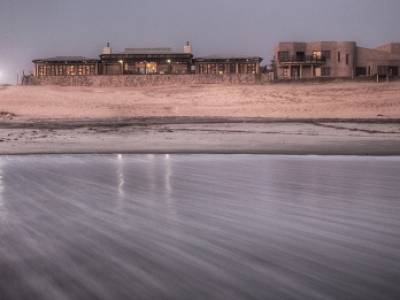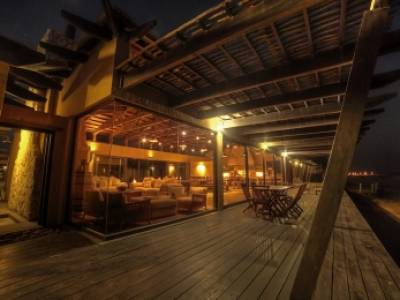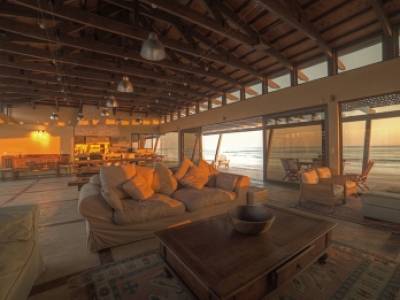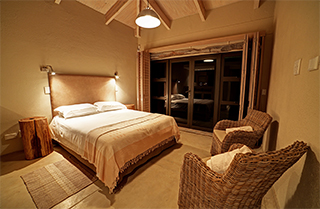About Us
To tourists, Nambia is known for turning up surprises when it is least expected. This time it is the rather sleepy fishing village of Henties Bay on the Skeleton Coast. Known as an excellent fishing destination, (think kabeljou, steenbras…) and the longstanding tradition of the inhabitants to give rather humoristic names to their fisherman’s cabins, Henties Bay has earned itself the reputation for being the “farmer’s Bahamas”.
It is therefore not the place to expect an award winning architectural holiday home. It all started back in the 1950’s when Oom Jan Hendrik and Tannie Mieta Labuschagne put up a simple two roomed cabin for fishing breakaways from their cattle farm in the Gobabis district, close to the Botswana border. Due to its rather humble nature, they named the cabin "Ietsie" (Afrikaans for something small or insignificant). Tragically, Oom Jan Hendrik died in a car accident near the Spitzkoppe in 1964 while returning from a fishing trip and with that those fishing expeditions to “Ietsie” came to an end.
Eben Labuschagne, one of Oom Jan Hendriks’ sons and his wife Janie surprised all their children with their impromptu decision to retire to Henties Bay with the result that their own 7 children and grandchildren made bi-annual visits to Henties Bay to celebrate Christmas and New Year together as a family. At this time land became available on the South Dune for development and Eben thought that it would be a good idea to erect a larger family home on a new site as their current dwelling was no longer large enough to suitably house all the family with the get-togethers. Eben unfortunately passed away soon after this but the seed was sown. The “siblings” together with all their spouses were all very keen to see Eben’s last wish materialise and the first of many concept plans for a new family house on the beach front started evolving. In 2005 they called in Namibian architect Conrad Scheffer, with a mandate that the house should reflect the Namibian landscape and not impose on the environment or the town. The house boasts building material from Namibia, such as the large stone lintels from the desert, hard quartz from the Gamsberg, light-coloured stone from the Swakop riverbed and with all masonry and carpentry completed by Namibian artisans
True to local tradition, the house now required a name and was subsequently called “Ietsiemeer” (Afrikaans for A little bit more) upon completion. The hub of the house is the pavilion area with more than 180 degrees sea view. This is where the clan, now scattered around the globe, come together to cook, eat and catch up, trying out new recipes and old favourites like sosaties (local kebabs), vetkoek or the traditional lamb on a spit for New Years Eve. Incidentally, the pavilion is named after the original family farm Hener, bringing everyone together. Apart from a sea facing deck from which to watch the dolphins playing in the sea by day and the spectacular sunsets of an evening, the house has an inner deck with a circular braai where a fire is always lit, everyone gathers around to put their feet up, enjoy a glass of wine and recall stories of days gone by or share their new adventures.
From its humble beginnings as Ietsie in the 1950’s, Ietsiemeer now not only welcomes a scattered close knit family to Namibia, but also hosts regular visitors from all over the world, such as the likes of Glenn Close. Whilst you may not know who these visitors are, you will be able to identify where they come from as their country’s flag is hoisted to welcome them, always accompanied by the Namibian flag, to make them feel at home!
From Ietsiemeer natural gems like the Spitzkoppe, the White Lady of the Brandberg, Cape Cross, and the Rhino sanctuary at the Ugab River, Sandwich Harbour and Dune Seven at Walvis Bay can be easily reached. Shopping trips to the historic German town of Swakopmund is only an hour away, with its renowned restaurants and pubs. However, you need not go anywhere as the most remarkable feature of Ietsiemeer is that there is almost nowhere inside where you would not see or hear the mighty Atlantic Ocean.
Ietsiemeer currently caters for groups of up to 20 people sharing and on a self-catering basis. Meals can be arranged on request. All rooms are en-suite, 6 of which are sea-facing and 4 opening onto the protected courtyard. The distinctly recognisable water tower structure, supporting a water tank moulded in the shape of a traditional mahango-grain silo, as found in northern Namibia, has become a landmark in Henties Bay.
Ietsiemeer offers luxurious self-catering accommodation for groups of up to 28 people, making it ideal for family holidays.
If you would like to get into contact with us, please fill out the form below and we will get back to you as soon as possible.







